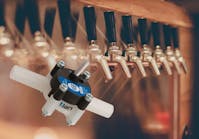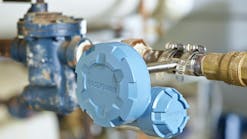In the food and beverage industry, Coke may add life, but the industrial internet of things (IIoT) and artificial intelligence (AI) lengthen it.
New technologies in processing have helped lengthen equipment life as well as improve quality control of the process. With IoT dominating new processes, smart valves and monitoring sensors regulate the volumes being dispensed and allow for flexible manufacturing all the way to the customer experience. For example, smart dispensing machines use valves with feedback technology to monitor the flow and mixture of soft drinks. These valves mix the product, control the balance and alert when one of the ingredients has run out.
IoT in processing
In food processing, improved control through the line is achieved by controlling the ingredients through dispensers and valves, which improves quality. The big payback for these system improvements is not only having greater control over ingredients but also having self-reporting failures. Now, the smart valves have memory in the device or in the hub, so when you swap out the valve, it remembers the settings and calibration data to quickly get back up and running. The data has increased so that the information received is not when a hopper is empty; rather, it constantly measures and provides estimated times until the product will be empty for better anticipation and product flow of raw materials in food and beverage plants.You can monitor the levels, temperatures, usage, waste, overall equipment efficiency (OEE) and predictive maintenance data. The big change for cloud information is that you can use plugins to apply detailed analytics to the data and make on-the-fly adjustments in the valve to control temperature when it determines the temperature needs to increase. The distribution of ingredients can also be checked to change the flow to make it more accurate and reduce waste.
In many applications, temperature and flow rate are equally important and can affect the actual mixture and absorption of some ingredients. This is also true at altitudes where foods can take longer to cook due to air pressure. With many options working hand-in-hand to control the quality of production, it is crucial to have better control through valves and actuators to regulate and monitor all aspects of production.
In food and beverage processing, cleanliness is king. The environment needs to be controlled meticulously, but this means you may have less ability to manually monitor the production, thus leading to more smart valves and IoT influence in food and beverage controls.
Controlling the flow through valves with feedback loops and external monitoring is dominating the destiny of manufacturing, especially in plants that have more than one product line and changeovers. These small bottling plants are especially susceptible to issues because the changeover times affect the OEE. Getting the valves to the proper settings and speeds does not happen with the flip of a switch; the speeds ramp up, which means the settings for all points of production must meet strict levels, or you risk huge waste numbers that do not meet quality inspection.
Many companies have the packaging feeding lines from buildings next door or occupy a space internal to the food or beverage manufacturing plant. These add another level of control that must be achieved in the IoT production plan, as they bring in external packaging from a third party, and it is not single item flow. In other words, packaging must be de-stacked so it can be fed into the line.
Canning processes oftentimes use air to reject bad parts or kick out bad products or use air valves to move products, such as buns and rolls.
Valves need to provide quick response and near immediate feedback to ensure correct timing. AI now offers a way to control feedback to monitor and accurately anticipate the correct part to approve or reject, which may need to change quickly depending on the environment. Technology for monitoring is requiring a better, smarter valve and actuator. They need to be able to respond quickly in any environment and any temperature with minimal downtime and minimal maintenance.
With an increasing demand in food production, we also see an increasing demand on equipment and production plants. Downtime can mean spoilage — a costly risk for food and beverage manufacturers. If a car sits for 24 hours, it won’t go bad. But, if food is exposed for any minor period, an entire batch of product may be wasted and result in thousands of dollars lost in retail sales.
IoT in packaging
Whether you fill bottles, cans or jugs with a beverage or if you fill a bowl, plate or container with food, there is the need for IoT.
From a management standpoint, IoT can be thought of as data nodes. These tiny, seemingly insignificant data points allow you to connect the dots and produce trends that can be used as key performance indicators (KPIs). In the old systems, we set a high and low limit for these KPIs, and we would act accordingly when we arrived at the limit. In some cases, a high limit indicated where you have maxed out the container that held the product and you needed to change the containers or packaging. On the low side, it might have indicated where product has run out.
In terms of AI being a living, breathing entity of information, which is not on or off, instead, it is the gray area in between that is more analog — trending better or worse. If we think in those terms, we can see that it does not do us any good to simply wait until we run out of bottles or until we have no more chicken to purchase; we want real-time feedback with real-time action.
The production line of packaging must be maximized to achieve the greatest production rates. Downtime is the enemy, and using AI can be thought of as maintaining a healthy life for the food and beverage industry.
Preventing downtime is not just reacting to the problem. In terms of the health in any line, preventive maintenance is like taking vitamins or probiotics for preventive health care. But since we cannot take the pills at times when we are out, we schedule our preventive care.
Planned and predictive become the optimum keys in a production line. A lot of planning went into the design and shape of the aluminum can. Why do we have the shape and why is it optimum? From early on, we realized the difficulty in manufacturing the packaging of beverage products. A square can would make it optimal for shelf space and shipping, but manufacturing and contour to the human hand would not be the best solution. A round shape can be quite difficult to stack and hold, and as soon as you let go on a table, it takes off. So, the cylinder was born — optimized for productivity, shelf space and shipping. Planning made that possible.
Planning in the manufacturing process is perhaps the most important aspect to maximize the health of the food and beverage lines. If planning is number 1, a near number 2 is execution. How we execute our plan can lead to a successful plan or an awful failure. AI can maximize implementation of the production plan. We take the information nodes and determine the optimal time to allow for minor tweaks in the system — all the way to line changeovers and major repairs.
Like in our own bodies, we need to allow enough time to recover and rehabilitate. Production lines are the same; we know how long these two actions should take and must allow adequate time and proper scheduling using AI to optimize that available time. Sometimes, that requires running ahead on production if possible, but more likely, it means making sure that we have addressed any shortages in our production to be compensated for in stock or in preparation.
The data points can be processed using AI programs to determine production opportunities where we can add production in preparation of significant downtime, not just minor changeovers from product to product. However, we may maximize changeover time to add productivity. This is where automation may show added value in the production with hidden savings. Not only the day-to-day savings but also minute-to-minute savings can provide added production time needed to fulfill delivery needs.
This can often be where return on investment (ROI) becomes a little cloudy if we are looking at just added production but not at reduced downtime or added availability. These should all be captured in an OEE plan, but too often, they are ignored.
If we look at the systems within beverage and food production as a human entity in the way AI does, we can compare it to time management. For example, a day planner allows us to maximize our day and make us more productive. The same is true in processing and packaging. We need to add systems that add value and time to our day. How do we maximize our available time and maximize efficiency of our downtime? It is through improved information and utilization so that we can plan and execute better.Joseph Zulick is a writer and manager at MRO Electric and Supply. For more information, go to mroelectric.com and josephzulick.com.




